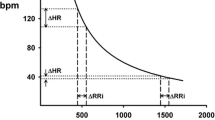Abstract
Exact assessment of the autonomic nervous system’s (ANS) activity by means of heart rate variability (HRV) is a long-standing challenge. Although many techniques have been proposed to take up the challenge, none ever proposed a rationale for the approach behind the technique or a satisfying discrimination of the two activities which underlie the autonomic control of HRV. We here propose a new method, providing both an understanding of the discrimination’s nature and a framework which we believe leads to a thorough assessment of the sympathovagal balance, as a trajectory between points in a well-chosen space. The methodology assumes tools from scale invariance/covariance physics. The sympathovagal balance is obtained on a beat-to-beat basis with the dynamics portrayed through a trajectory. Furthermore, universal trajectories are sought which would comprehensively describe the effect of atropine and isoproterenol injections on systems underlying the heart pace variations. Non-invasive assessment of the respective activities of the sympathetic and parasympathetic subsystems of the ANS would be possible through cardiac autonomic measurements.






Similar content being viewed by others
References
Abbott LF, Wise MB (1981) Dimension of a quantum-mechanical path. Am J Phys 49:37–39
Balocchi R, Menicucci D, Santarcangelo E, Sebastiani L, Gemignani A, Ghelarducci B, Varanini M (2004) Deriving the respiratory sinus arrhythmia from the heartbeat time-series using empirical mode decomposition. Chaos Solitons Fractals 20:171–177
Beckers F, Verheyden B et al (2005) Ageing and non-linear heart rate control in a healthy population. Am J Physiol Heart Circ Physiol O:9032005
Bianchi AM, Mainardi LT, Merloni C, Chierchia S, Cerutti S (1997) Continuous monitoring of the sympatho-vagal balance through spectral analysis. IEEE Eng Med Biol 16:64–73
Committee to Revise the Guidelines for Ambulatory Electrocardiography (1999) Acc/aha guidelines for ambulatory electrocardiography. J Am College Cardiol 3:913–948
Dubrulle B (1994) Intermittency in fully developed turbulence: log-Poisson statistics and generalized scale covariance. Phys Rev Lett 73:959–962
Dubrulle B, Graner F (1996) Possible statistics of scale invariant systems. J Phys 6:797–816
Dubrulle B, Graner F (1996) Scale invariance and scaling exponents in fully developed turbulence. J Phys 6:817–824
Dubrulle B, Bréon FM, Graner F, Pocheau A (1998) Towards an universal classification of scale invariant processes. Eur Phys J B 4:89–94
Eckberg DL (1997) Sympathovagal balance: a critical appraisal. Circulation 96:3224–3232
Feigenbaum MJ (1988) Presentation functions, fixed points, and a theory of scaling function dynamics. J Stat Phys 52:527–569
Feynman RP (1949) Space-time approach to quantum electrodynamics. Phys Rev 766:769
Feynman RP, Hibbs AR (1965) Quantum mechanics and path integrals. MacGraw-Hill, New York
Mäkikallio TH, Ristimae T et al (1998) Heart rate dynamics in patients with stable angina pectoris and utility of fractal and complexity measures. Am J Cardiol 81:27–31
Mäkikallio TH, Seppänen T et al (1997) Dynamic analysis of heart rate may predict subsequent ventricular tachycardia after myocardial infarction. Am J Cardiol 80:779–783
Malliani A (2000) Principles of cardiovascular neural regulation in health and disease. Kluwer, Dordrecht
Malliani A, Pagani M, Montano N, Mela S (1998) Sympathovagal balance: a reappraisal. Circulation 98:2640–2642
Mandelbrot B (1982) The fractal geometry of nature. Freeman, San Francisco, pp 184, 331–332
Mandelbrot BB (1997) Fractals and scaling in finance. Springer, Berlin Heidelberg New York, pp 29–31, 103–104, 50–78
Mandelbrot BB (2004) Fractals and chaos. Springer, Berlin Heidelberg New York, pp 23–36, ix–xii, 276–280, 50–51
de Melo W, Van Strien S (1993) One-dimensional dynamics. Springer, Berlin Heidelberg New York
Nottale L (1993) Fractal space-time and microphysics: towards a theory of scale relativity. World Scientific, Singapore
Nottale L (1997) Scale relativity, in scale invariance and beyond. In: Dubrulle B, Graner F, Sornette D (eds) Proceedings of Les Houches school, EDP Sciences, Les Ullis/Springer, Berlin Heidelberg New York, pp 249–261
Nottale L, Schneider J (1984) Fractals and non-standard analysis. J Math Phys 25:1296
Nottale L (2006) The theory of scale relativity: non-differentiable geometry and fractal space-time. In: Proceedings of AIP Conference 2004 (in press)
Perkiomaki JS, Makikallio TH, Huikuri HV (2005) Fractal and complexity measures of heart rate variability. Clin Exp Hypertens 27(2, 3):149–158
R Luzzatto MH (1805) Qlach pitchey chokhmah. Koretz, openings 49–50
Shin DG, Yoo CS et al (2006) Prediction of paroxysmal atrial fibrillation using nonlinear analysis of the R-R interval dynamics before the spontaneous onset of atrial fibrillation. Circ J 70(1):94–99
Sleight P, Bernardi L (1998) Sympathovagal balance. Circulation 98:2640
Task Force of The European Society of Cardiology, The North American Society of Pacing and Electrophysiology (1996) Heart rate variability. Eur Heart J 17:354–381
Wolfram S (2002) A new kind of science. Wolfram Media, Champaign, pp 363–369, 434, 857
Yang C, Kuo T (1999) Assessment of cardiac sympathetic regulation by respiratory-related arterial pressure variability in the rat. J Physiol 515:887–896
Zhong Y, Wang H, Jan K, Ju K, Chon KH (2004) Separation of the sympathetic and parasympathetic tone using principal dynamic mode analysis. IEEE Trans BME 51:255–262
Acknowledgment
The first three authors gladly acknowledge financial support from Dyansys, Inc.
Author information
Authors and Affiliations
Corresponding author
Rights and permissions
About this article
Cite this article
Lafitte, M.J., Sauvageot, O.R., Fevre-Genoulaz, M. et al. Towards assessing the sympathovagal balance. Med Bio Eng Comput 44, 675–682 (2006). https://doi.org/10.1007/s11517-006-0053-1
Received:
Accepted:
Published:
Issue Date:
DOI: https://doi.org/10.1007/s11517-006-0053-1




